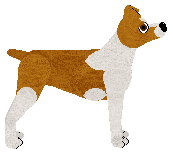Solid:









Tan:





 may have
may have 

 in the traditional or creeping pattern.
in the traditional or creeping pattern.Masking: All of the above may be masked (standard mask). The mask can be





 and matches pigment type - black in black-based dogs, liver in livers etc.
and matches pigment type - black in black-based dogs, liver in livers etc.White Markings: American hairless terrier must always have some white (always represented by pale pink in this variety) somewhere on the body and may be solid white (pink) all over. Ticking is allowed.
When surrounded by white (pink), the liplines in this variety may be flesh without fault, regardless of pigment type.
Coated variety
Solid:









Brindle: Allowed brindle combinations are


 with
with 

 striping
striping
 with
with 
 striping
striping with
with  striping.
striping.Sable: Any sable combination in any of the patterns.
Tan:





 with
with 

 in the traditional or creeping pattern, points may be brindled.
in the traditional or creeping pattern, points may be brindled. dogs may also have
dogs may also have  markings.
markings.Masking: All of the above may be masked (standard mask). The mask can be




 and matches pigment type - black in black-based dogs, liver in livers etc.
and matches pigment type - black in black-based dogs, liver in livers etc. 

 dogs can be masked with any of the mask colours. Masks are not preferred in all non-tan-marked dogs.
dogs can be masked with any of the mask colours. Masks are not preferred in all non-tan-marked dogs.White Markings: The american hairless terrier must always have some
 somewhere on the body and may be solid
somewhere on the body and may be solid  all over. Ticking is allowed but the white must be clearly visible.
all over. Ticking is allowed but the white must be clearly visible.
 in black-nosed dogz,
in black-nosed dogz, 
 in blue- and liver-nosed dogz,
in blue- and liver-nosed dogz, 




